While occupied on some travel, I am pleased to provide a pilot report on a Part 103-type from across the Atlantic in the United Kingdom. Who better to report this to you than my counterpart in Britain, Dave Unwin. Dave has flown a huge number of aircraft of all sizes. When he writes about lighter aircraft, I enjoy presenting his views. Comments in italic are my amplifications. This time I present Dave’s article with minimal editing so you can enjoy his British style. This means it is longer than our usual fare but I found it a fun read and I hope you will, too…
All the great pictures were shot by photographer extraordinaire, Keith Wilson. Thanks to Dave and Keith for a great story. —DJ
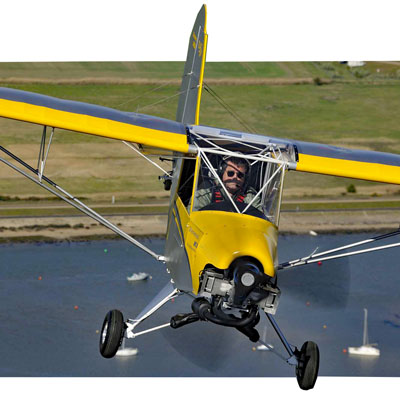
I give you the Sherwood Kub. Built by The Light Aircraft Company (TLAC) at Little Snoring Airfield in Norfolk, the Kub is a high-wing, single seater which falls into the snappily-titled Single Seat Deregulated category, or SSDR. As the name implies, an SSDR aircraft can only have a single seat, and in the UK it must stall at less than 35 knots and have a MAUW (maximum all up weight) no greater than 300 kilograms (some countries alternatively specify an empty weight of either 115 or 120 kilograms — the U.S. Part 103 number of 254 pounds or 115 kilograms).
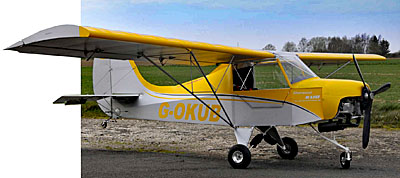
Kub, the Machine
Wandering out to look at the test machine reveals an interesting anomaly; unlike any other aircraft I’ve ever flown (but similar to the Kolb TriFly), “Golf Oscar Kilo Uniform Bravo” appears to have both a nosewheel and a tailwheel! TLAC’s Chief Pilot James Milne explains that the Kub shares several similar features as its big brother the Scout, including being offered with different engine options, having quick-folding wings and being easily reconfigured with either a nosewheel or tailwheel undercarriage. “The mainwheels are set up for a nosewheel” he explains, “but we thought we’d leave the tailwheel on for a laugh; to see if you’d notice!”
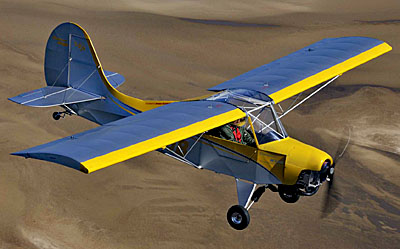
The Hirth F23 is an air-cooled horizontally-opposed two-stroke twin, which produces 50 horsepower at 6150 rpm and turns the three-blade, fixed-pitch prop via a wide Polyflex V-belt drive with a reduction ratio of 2.2:1. James explains that initially G-OKUB (British “N-numbers” start with a “G”) had been fitted with a Hirth F33 single-cylinder two-stroke of only 33 horsepower, but this was soon replaced with the F23, which, he grinned, “has transformed it!”
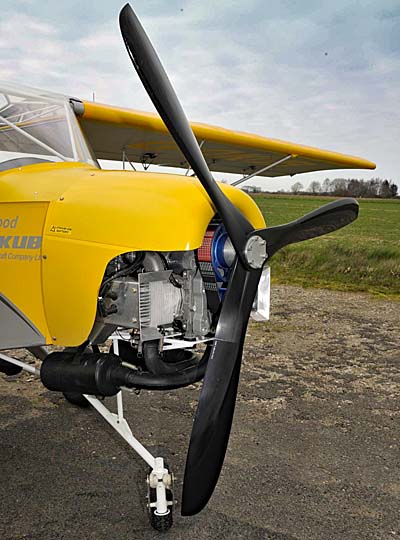
The main undercarriage is of the split-vee type fitted with chubby low-pressure tires and heavily slotted Shimano cable-actuated disc brakes. Bungees are used for shock absorption. As both ‘third wheels’ were fitted, it made this particular preflight unique, at least in my experience. The large pneumatic nosewheel is carried by a welded steel-tube frame and free-castors, while the small solid tailwheel is suspended from a single leaf spring and steers via springs through the rudder pedals, up to about thirty degrees each way. A mixture of struts and wires brace the tailplane, which carries separate elevators with a large trim tab set into the trailing edge of the starboard one. The big fin is pleasingly rounded and carries an equally large rudder.
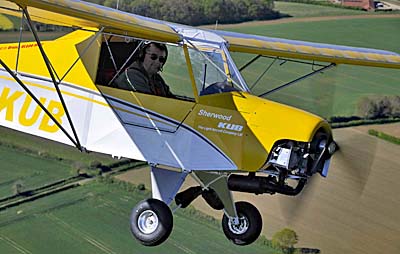
In-Flight Evaluation
Access to the cockpit is via a split window/door on the starboard side. The door opens forward and is quite small, while the upward-opening window is big. Most Kubs also have an identical window to port. Unsurprisingly, neither the seat nor pedals adjust, but luckily it fits me quite nicely, so once firmly strapped in with the well-made Willians four-point harness I study the surprisingly large cockpit’s controls and instruments. Quite predictably it’s an exercise in minimalism. The tall stick carries twin bicycle-type brake levers, while levers for the throttle, trim and flaps are on the port sidewall by your left knee, hip and elbow respectively. The panel continues the minimalist motif with a centrally-mounted MGL Stratomaster Xtreme EFIS as the primary instrument for both flight and engine information, with a back-up analog altimeter and ASI below it and a slip-ball between them. The ASI reads in mph and somewhat optimistic (about a third of the scale is basically superfluous) and the altimeter not ideal, as it only has a single pointer.
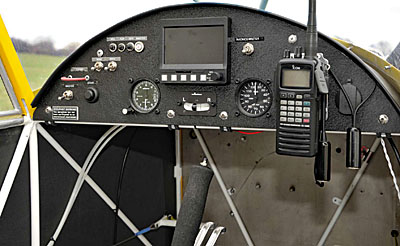
Now it’s time for my mea culpa moment. James had turned on the master and avionics to brief me on the EFIS, and then said, “off you go,” so I set throttle and choke, shouted “clear prop” and pressed the starter. The propeller whirled most convincingly, but the motor didn’t even cough. Further attempts were equally unsatisfactory, then realisation dawned on James and I simultaneously – maybe turning on the dual ignition systems might help? This was the first time I’d ever made this fundamental mistake on a test flight! Lesson learned: if someone else has turned on some of the systems it’s always best to turn off everything and then start from the start, before trying to start! Incidentally, the choke isn’t great (but they’re working on it). It’s spring-loaded to the off position and as there’s no parking brake, you run out of hands as you also need to press the starter and guard the throttle. Taxiing out using the hand-operated differential brakes is quite easy, once I’d remembered that — as with all aircraft fitted with a castoring nosewheel — its easier if you keep the speed up a bit.
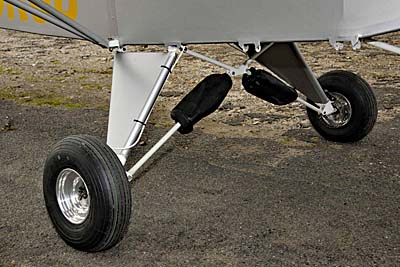
I saw no need to taxi round to runway 25; I simply set the flaps to 10°, opened the throttle and took off from the taxiway. Ambient conditions are above ISA, with an airfield elevation of 196 feet and an OAT of 20°C (68°F). With both tanks full G-OKUB is about 44 kilograms (97 pounds) below the 300 kilogram MAUW. I had a slight crosswind from port but the acceleration is so brisk that the Kub is up and away after about fifty meters (165 feet). The climb rate is equally impressive, the Vy of 45 knots producing over 1,000 fpm. The weather was not good for air-to-air picture taking, so photographer Keith stayed on the ground while I headed off to the west to explore the general handling, control, and stability. Initial impressions were all good. Kub handling is fine around all three axes, with low break-out forces and little “stiction.” Unsurprisingly, slow flight is slow. The strut-braced wing uses a relatively high-lift aerofoil and the loading is quite light, barely half that of a Cessna 150.
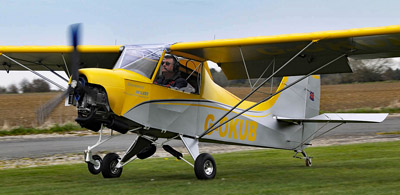
Regarding stick-free stability, the Kub is stable around all three axes, being quite positive longitudinally, softly positive directionally and just barely positive laterally. The roll rate is, as you’d imagine, quite nippy while the visibility in the turn (and most phases of flight) is quite good for a high-wing aircraft.
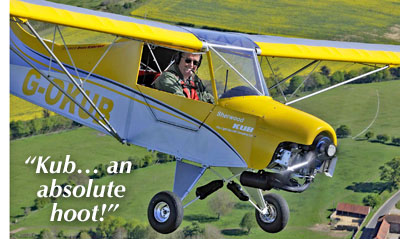
For my first landing I opt for runway 25, which is wider, longer, and directly into wind. This goes well, and as I can see Keith has positioned himself by the mown grass strip (Runway 28) next to the taxiway to shoot some take-off and landing shots I fly several for the camera. This is great fun. The simple pleasure of a well-flown approach never grows old, while the subtle and seamless transference of weight from wing to wheel and back again has never paled, especially if you’ve got an open cockpit (or large window open) and the runway is grass. (This sentence alone is enough to appreciate Dave, don’t you think?) As mentioned earlier the test aircraft had a third wheel at both ends and just for laughs (and with a bit of application) I even managed a three-pointer.
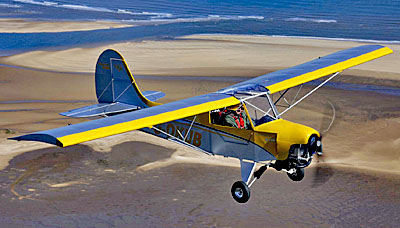
I also examine the take-off and landing performance with various flap settings and eventually tried the ultimate test by inverting all normal procedures by taking off with full flap and then landing with no flap. Conclusion: you don’t need any flap at any time, except when folding the wings! My experiments had convinced me that the weight and complexity of the flap system’s lever, cables, pulleys and bell cranks is unnecessary and that — and particularly for the 50 horsepower version — simple pip-pins could be used to hold the flaps in place when rigged for flight.
A few weeks later Keith and I are back, and the weather is great. This time G-OKUB lost the the “training [tail]wheel” and is configured as a taildragger. It looks a lot better, I think. In fact, it looks a little bit like a single seat miniature Aeronca Champ. Slightly chubby and cheeky-looking, it exudes fun. Taxiing out was if anything (and unusually) easier in the taildragger then the trike. S-turning is unnecessary, as visibility over and each side of the nose is good and the tailwheel steers through the rudder pedals whereas the castering nosewheel requires differential braking. While best rate of climb is 45 knots, once I rose above 500 feet I sped up to 55, as this not only improves the view over the nose but also gets me clear of the airfield and chasing the camera Cessna 152 a bit quicker.
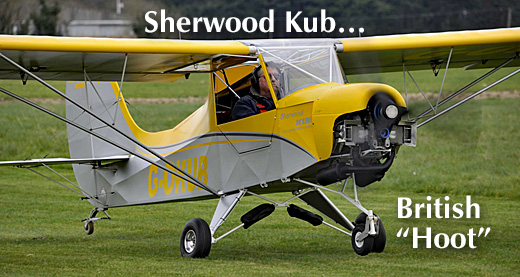
During my two test flights I had a lot of fun with the Kub — it’s an absolute hoot! Even the two-stroke engine impressed me; it really does pull well and the rate of climb is spectacular. It really was great fun to bumble about the sky with my elbow out the open window. The handling is crisp, the roll rate nippy and its just… well, fun, for there’s something very special about flying rag ‘n’ tube taildraggers from grass; something that is difficult to explain and hard to resist.
So, would a Kub work for you? Ultimately, the only question you need to ask yourself is, “Do I go flying for sixty miles, or for sixty minutes?
(At this time, TLAC’s Kub is not offered for sale in the USA.)
Sherwood KUB Specifications
- Price as tested — £34,250 (about $42,000 at current exchange rates)
- Aircraft can be fitted with a variety of engines and a nose or tailwheel undercarriage.
- Length — 16 feet
- Height — 5.2 feet
- Wing span — 29 feet / 8 feet (folded)
- Empty weight — 297 pounds
- Gross Weight — 661 pounds
- Useful load — 364 pounds
- Fuel Capacity — 13.6 gallons
- Baggage Capacity — 22 pounds
- Vne — 86 knots
- Cruise — 50 knots
- Stall — 22 knots
- Climb Rate — 1000 fpm
- Takeoff over 50 feet — 325 feet
- Land over 50 feet — 325 feet


Would Like more info !!!
Hi Sidney: Links appear in the article. Please go direct to Sherwood.